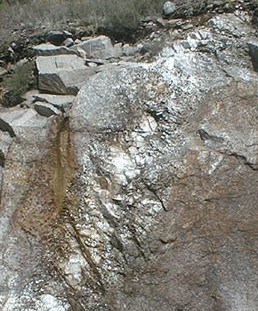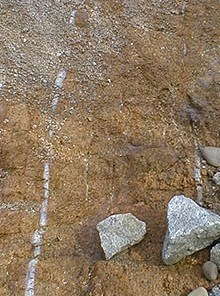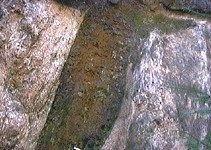|

Os Filões
As fracturas nas rochas ígneas podem ser local de circulação e instalação de magmas e soluções aquosas quentes, com consequente cristalização/precipitação de minerais de composição química variada. O preenchimento das fracturas gera corpos mais ou menos tabulares, com espessuras que poderão ser da ordem de milímetros ou centímetros (formando filonetes) até muitos metros (filões).
Nos granitos e metassedimentos ocorrem filões de rochas básicas, de quartzo e filões e massas aplito-pegmatíticos. Alguns dos filões de quartzo e aplito-pegmatitos apresentam-se mineralizadas, tendo havido no passado explorações mineiras de estanho, volfrâmio, molibdénio e ouro (tal como as antigas minas de Carris e Borrageiro). Infelizmente, muito deste património geológico tem sido destruído ao longo dos anos
FILÕES E MASSAS DE PEGMATITOS, APLITOS E APLITO-PEGMATITOS

Os filões e massas de aplitos e pegmatitos representam a porção mais hidratada e de cristalização mais tardia de um magma. Nos últimos estádios da cristalização magmática os magmas residuais são enriquecidos em voláteis tais como água, flúor e boro. Podem ainda conter outros elementos químicos que não entraram na estrutura dos minerais já formados e que, por isso, se concentraram neste magma residual, tais como Be e Sn, entre muitos outros. Como resultado disso, a partir do magma residual podem cristalizar minerais raros em que estes elementos são constituintes essenciais, tais como berilo (silicato de alumínio e berílio), cassiterite (óxido de estanho), topázio (silicato de alumínio e flúor) e turmalina (silicato complexo com boro, ferro e sódio).
Os pegmatitos e aplitos têm composições muito diversas, mas a maioria tem composição granítica, com quartzo, feldpato potássico e albite, designando-se então de pegmatitos graníticos. É o caso dos pegmatitos e aplitos que ocorrem na área do Parque (ilustrado na fotografia da direita).
Num mesmo filão pode co-existir preenchimento aplítico e pegmatítico, com a porção pegmatítica na zona central e uma zona aplítica na periferia ou vice-versa.
FILÕES DE QUARTZO

Nas fracturas podem circular soluções aquosas quentes (fluidos hidrotermais), de origem magmática ou outra, permitindo a precipitação de minerais que, assim, constituem os chamados filões hidrotermais. Estes são, em geral, consideravelmente mais longos que espessos (tipicamente, 100 a 1000 vezes).
A circulação de fluidos enriquecidos em sílica permite a formação de filões e filonetes de quartzo, de ocorrência frequente na área do PNPG (como os da fotografia da direita), sobretudo no granito de Gerês. Eles encontram-se, por vezes, a preencher zonas de falha. O movimento ao longo da falha provoca esmagamento do material silicioso, dando-lhe, dessa forma, um aspecto de brecha. Ao quartzo associam-se, por vezes, óxidos de ferro ou sulfuretos disseminada.
FILÕES DE ROCHAS BÁSICAS

Magmas de composição básica também preenchem, frequentemente, fracturas nas rochas graníticas, originando filões com uma coloração escura que é devida à abundância de minerais ferromagnesianos (como piroxena, anfíbola, biotite, etc). A sua textura é claramente mais fina do que a de rochas ígneas plutónicas, como os granitos. Tal deve-se ao facto da sua cristalização, embora tendo lugar em profundidade, ser mais rápida do que nos granitos. Na verdade, os magmas de natureza básica, ao arrefecer, iniciam a sua cristalização a temperaturas mais elevadas do que os magmas graníticos e, além disso, se intruirem fracturas da parte superior da crusta tendem a arrefecer mais rapidamente devido ao contraste térmico com as rochas encaixantes.
Devido à sua composição rica em minerais ferromagnesianos, estas rochas são facilmente meteorizadas, pois tais minerais são mais susceptíveis à alteração do que o quartzo e o feldspato potássico. Será, por essa razão, de prever que um filão de rocha básica se apresente mais alterado do que a rocha granítica envolvente. Esta transformação é bem visível nos filões de rocha básica que ocorrem na área do Parque, intensamente alterados para uma massa argilosa de cor castanha (fotografia da direita).
|

The Lode
Fractures in igneous rocks can be the place of circulation and installation of hot aqueous magmas and solutions, with consequent crystallization / precipitation of minerals of varied chemical composition. The filling of the fractures generates more or less tabular bodies, with thicknesses that can be of the order of millimeters or centimeters (forming fillets) up to many meters (veins).
In granites and metasediments, there are layers of basic rocks, quartz and aplito-pegmatite veins and masses. Some of the quartz and aplito-pegmatite veins are mineralized, and in the past there have been tin, tungsten, molybdenum and gold mining operations (such as the former Carris and Borrageiro mines). Unfortunately, much of this geological heritage has been destroyed over the years.
PEGMATE, APPLIED AND APPLIED-PEGMATE FILONS AND PASTA

The lumps and masses of aplites and pegmatites represent the most hydrated and later crystallizing portion of a magma. In the later stages of magmatic crystallization, residual magmas are enriched in volatiles such as water, fluorine and boron. They may also contain other chemical elements that have not entered the structure of the minerals that have already formed and which have therefore concentrated on this residual magma, such as Be and Sn, among many others. As a result, from the residual magma can crystallize rare minerals where these elements are essential constituents such as beryl (aluminum and beryllium silicate), cassiterite (tin oxide), topaz (fluorine aluminum silicate) and tourmaline ( complex silicate with boron, iron and sodium).
Pegmatites and aplites have very different compositions, but most have granite composition, with quartz, potassium feldpate and albite, being called granite pegmatites. This is the case of pegmatites and aplites that occur in the Park area (illustrated in the photograph on the right).
In the same vein there may be co-existing aplitic and pegmatitic fill, with the pegmatitic portion in the central zone and an aplitic zone in the periphery or vice versa.
QUARTZ LODES

In the fractures, hot aqueous solutions (hydrothermal fluids) of magmatic or other origin may circulate, allowing the precipitation of minerals that thus constitute the so-called hydrothermal veins. These are generally considerably longer than thick (typically 100 to 1000 times).
The circulation of silica-enriched fluids allows the formation of quartz veins and fillets, frequently occurring in the area of PNPG (as in the picture on the right), especially in Gerês granite. They are sometimes filling in fault zones. Movement along the fault causes the silicon material to crush, thereby giving it a loophole aspect. Quartz is sometimes associated with iron oxides or disseminated sulphides.
BASIC ROCK LODES

Magmas of basic composition also often fill fractures in granitic rocks, giving rise to darkly colored lumps due to the abundance of ferromagnesian minerals (such as pyroxene, amphibole, biotite, etc.). Its texture is clearly finer than that of plutonic igneous rocks such as granites. This is because its crystallization, although taking place in depth, is faster than in granites. In fact, basic magmas, upon cooling, begin to crystallize at higher temperatures than granitic magmas and, furthermore, if crusta upper crust fractures tend to cool faster due to the thermal contrast with the rocks. snapping.
Due to their rich composition of ferromagnesian minerals, these rocks are easily weathered, as these minerals are more susceptible to change than quartz and potassium feldspar. For this reason, it is to be expected that a basic rock lode will appear more altered than the surrounding granite rock. This transformation is clearly visible in the lumps of basic rock that occur in the Park area, which have been intensely altered to a brownish clay mass (photo on the right).
|